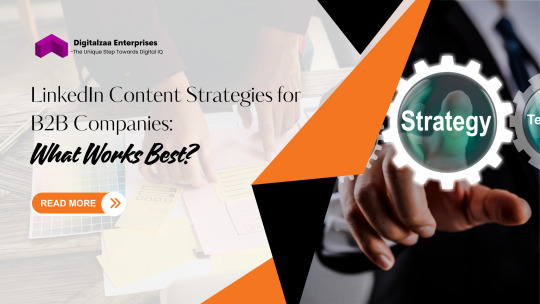#B2B Leadership
Explore tagged Tumblr posts
Text
Driving Growth Through GTM and Innovation: Mandeep Taunk’s Journey
Navigating the complex landscape of Go-to-Market (GTM) strategies in B2B marketing requires a blend of creativity, foresight, and technical expertise. Mandeep Taunk, a seasoned leader in product marketing and entrepreneurship, offers invaluable insights into crafting GTM strategies that drive growth, foster innovation, and align teams for success. In this blog, we delve into key lessons from Mandeep’s expertise.
What Makes a Winning GTM Strategy?
A robust GTM strategy is the foundation of successful product launches and market penetration. Mandeep emphasizes that a clear value proposition is the cornerstone of an effective GTM plan.
Get full insights@ https://itechseries.com/interviews/gtm-insights-from-mandeep-taunk/
In B2B marketing, understanding the pain points of target audiences and addressing them directly is critical. By aligning your product messaging with customer needs, you establish trust and differentiate your offering from competitors.
The Intersection of Leadership and Marketing
Leadership strategy plays a pivotal role in the execution of GTM strategies. Mandeep advocates for empowering cross-functional teams to foster collaboration and innovation.
When leaders prioritize open communication and shared goals, it becomes easier to align marketing, sales, and product teams. This alignment not only accelerates time-to-market but also ensures consistency in messaging across channels.

The Role of Technology in Modern GTM Strategies
In today’s digital age, technology is a critical enabler of GTM success. From customer relationship management (CRM) tools to data analytics platforms, technology streamlines operations and provides actionable insights.
Mandeep suggests leveraging advanced tools to gain a 360-degree view of customer behavior. These insights enable B2B marketers to create personalized campaigns that resonate with specific audience segments.
Entrepreneurship and GTM: What Can We Learn?
Entrepreneurs often face unique challenges in bringing products to market. Mandeep highlights the importance of agility and adaptability in these scenarios.
Startups and small businesses can benefit from a lean GTM approach, focusing on core strengths and iterating based on market feedback. This entrepreneurial mindset ensures continuous improvement and alignment with customer needs.
Explore the latest marketing and tech insights@ https://itechseries.com/gtm-library/
Building Cross-Functional Teams for GTM Success
A successful GTM strategy relies heavily on cross-functional collaboration. Mandeep underscores the importance of creating teams that integrate expertise from marketing, sales, and product development.
When teams work together towards shared objectives, they can identify opportunities, mitigate risks, and execute campaigns more efficiently. This unified approach fosters a culture of innovation and accountability.
Why Product Marketing is Central to GTM Strategies
Product marketing bridges the gap between product development and customer engagement. Mandeep views product marketers as the architects of GTM strategies, responsible for translating technical features into compelling benefits.
By conducting market research and competitive analysis, product marketers can craft messages that resonate with B2B audiences. Their role is instrumental in ensuring that the product aligns with market demand.
How to Align Leadership Strategy with Market Needs
Effective leadership involves balancing long-term vision with immediate market demands. According to Mandeep, leaders must remain customer-centric while driving innovation within their teams.
By fostering a culture of continuous learning, leaders can adapt their strategies to evolving market trends. This adaptability is key to sustaining relevance in a competitive B2B landscape.
Lessons from Mandeep: The Future of GTM Strategies
Looking ahead, Mandeep predicts that data-driven decision-making and personalization will continue to shape GTM strategies. Businesses that invest in advanced analytics and AI-powered tools will gain a competitive edge.
Moreover, Mandeep stresses the importance of ethical marketing practices. Transparency and authenticity are essential in building lasting relationships with B2B customers.
Conclusion
Mandeep Taunk’s insights offer a roadmap for navigating the intricate world of GTM strategies, entrepreneurship, and product marketing. By focusing on customer needs, leveraging technology, and fostering collaboration, B2B marketers can drive growth and achieve long-term success.
#GTM Strategies#Product Marketing#Growth Marketing#B2B Leadership#Product Market Fit#AI#Lead Generation
0 notes
Text
#b2b sales#salestips#business#sales techniques#sales manager#leadership#sales management#sales#sales training#sales tips
2 notes
·
View notes
Text
How to Integrate Thought Leadership Strategy into Your B2B Marketing Plan

Credible businesses seamlessly earn investor funding and form long-term relationships with all stakeholders. However, establishing authority is a slow, complicated process. Enterprises must also encourage in-house veterans to be more open about engaging with industry peers and assist the marketing team with high retention activities. This post will explain what organizations need to integrate a thought leadership strategy into a business-to-business (B2B) marketing plan.
Understanding B2B Thought Leadership
Unlike customer-focused guidance abundant on e-commerce sites, B2B thought leadership targets industry peers and client organizations. Therefore, ensuring a true thought leader position by highlighting your brand’s team of experts with their actual contributions to the industry is crucial.
Current clients, prospects, suppliers, aspiring young professionals, and independent practitioners in each discipline can benefit from educational and engaging content that thought leaders publish. As a result, B2B thought leadership enables corporations to advocate for new norms, like green tech adoption or culturally conscious communication.
For example, today, many leading firms in information technology and applied sciences encourage a balanced approach to artificial intelligence. Whitepapers, case studies, live events, webinars, debate forums, and special expos allow them to network with like-minded professionals. At the same time, they demonstrate their values and ethos that might resonate with potential investors having similar concerns about ethical AI integration.
How to Integrate a Thought Leadership Strategy into Your B2B Marketing Plan
Step 1: Make Subject Matter Experts Participate in Social Media and Industry Forums
Social networking sites (SNS) are no longer secondary to industry-specific discussion and support forums when it comes to thought leadership marketing. Both are impactful, considering how younger professionals do not shy away from utilizing all platforms to acquire new skills and connect with renowned subject matter experts or SMEs.
First, every enterprise must train and direct employees to gain exposure to on-ground activities relating to multiple projects. While those holding senior positions can offer more insightful content as SMEs, younger workers can also help explore or present experimental ideas to relevant audiences. Neither group can afford to have inconsistent presences on their social media profiles. Later, they can direct their followers or forum members toward more engaging lead magnets and technical knowledge resources.
Step 2: Define the Correct Guidelines to Help SMEs Engage with Critics, Followers, and Event Attendees
All channels for B2B thought leadership involve two-way communication aspects. That is why actively participating in discussions is most beneficial. On the one hand, your team members get to build their personal brand and thrive as SMEs. Simultaneously, your enterprises acquire newer opportunities to demonstrate authenticity.
Engagement is not limited to the number of likes or reposts. Given the rise of superficial “engagement farm” scams, all audiences care more about comments. It is no wonder that relevance and professionalism during commenting can strengthen or dampen the thought leadership effects. Selecting content moderators and thought leaders who understand whether sarcastic remarks can lead to healthy debates or toxic responses might be the greatest challenge in this case.
Step 3: Do Not Turn Down Collaboration Opportunities Without Thorough Consideration
Sharing insights can be less lonely when SMEs team up with other thought leaders covering identical frameworks and industry practices. Based on personal comfort zones, some thought leadership contributors might not be willing to collaborate with others. That indicates a need for continuous skill development that prepares them for collaborative public speaking and live-streaming content creation.
You will notice that LinkedIn, Instagram, YouTube, TikTok, and Pinterest have embraced short videos and live streams. Audiences are also tired of information fatigue and seek more organic interactions between discussion panel members. These trends have increased the significance of collaborations and audiovisual aspects in a B2B marketing plan. Therefore, thought leaders cannot ignore the related skills or collaboration invitations.
Conclusion
Producing content backed by real-world evidence is fundamental to B2B thought leadership. However, strategically utilizing it requires voluntary contributions from seasoned professionals and young recruits. The former can excel at demonstrating domain expertise through whitepaper publications, public speaking events, and technical knowledge dissemination. The latter will aid in experimental projects and challenge conventional wisdom.
In short, each category of subject matter experts provides unique advantages that assist marketers in enhancing brands’ authority-building initiatives. As a result, companies enthusiastically aiming to integrate a thought leadership strategy into the B2B marketing plan must follow the aforementioned steps. Doing so will help them thrive on multiple platforms and attract stakeholders through credible content distribution.
0 notes
Text
Victim to Victory Podcast Series Interview. Dare to be a dreamer with loyal INXS fan Richard Blank.
Victim to Victory Podcast, Tracey Cook, Richard Blank, Costa Rica's Call Center, Outsourcing, Telemarketing Call Centre, BPO, Nearshore Contact Center, Sales, Entrepreneur, B2B, Business, Podcast, Gamification,Leadership, Marketing, CX, Guest, Money, B2C

View On WordPress
#B2B#B2C education#BPO#BPO TRAINER#Business#Costa Rica&039;s Call Center#cx#Entrepreneur#GAMIFICATION#Guest#Leadership#Marketing#money#Nearshore Contact Center#outsourcing#PODCAST#RICHARD BLANK#Sales#TELEMARKETING CALL CENTRE#Tracey Cook#Victim to Victory Podcast
0 notes
Text

In today’s competitive digital landscape, LinkedIn has emerged as a crucial platform for B2B companies to connect, engage, and grow their professional networks. With over 930 million professionals active on LinkedIn, it's a treasure trove of opportunities for businesses looking to establish authority, generate leads, and build meaningful relationships. However, success on LinkedIn requires a tailored approach that focuses on LinkedIn content strategies specifically designed for B2B audiences.
#linkedinmarketing#b2bmarketing#content strategy#leadgeneration#thought leadership#LinkedInForBusiness#audience engagement#ProfessionalNetworking#linkedin ads#b2b content marketing#digitalmarketingstrategy#SocialMediaForBusiness#LinkedInOptimization#businessnetworking#targetedmarketing#digitalzaaenterprises
0 notes
Text
1 note
·
View note
Text

Business growth is not about avoiding challenges but embracing them with the right approach.💼👨🏻💼
#BusinessGrowth#EntrepreneurLife#StartupJourney#BusinessStrategy#Innovation#Leadership#BusinessMindset#SuccessStory#B2B#NetworkingOpportunities#CollaborateToGrow#BusinessPartnerships#EntrepreneurshipCommunity#BusinessFinance#InvestmentOpportunities#WealthManagement#FinancialFreedom
0 notes
Text
Vendor Management Made Easy: Embrace VMS Software

Vendor Management System (VMS) software is designed to help organizations manage their vendor relationships and streamline procurement processes. This specialized software provides a centralized platform for tracking vendor performance, managing contracts, and overseeing compliance. With a well-implemented VMS, businesses can automate many of the mundane tasks associated with vendor management, freeing up time for IT professionals to focus on strategic initiatives.
Key Features of VMS Software
Centralized Database: A VMS provides a single repository for all vendor-related information, making it easier to track contracts, performance metrics, and compliance documents.
Performance Tracking: Many VMS solutions offer tools to monitor vendor performance through key performance indicators (KPIs). This helps organizations assess the value each vendor brings and make data-driven decisions.
Automated Workflows: VMS software can automate various processes, such as onboarding new vendors, contract renewals, and performance reviews, reducing manual errors and increasing efficiency.
Reporting and Analytics: With robust reporting tools, VMS software can provide insights into spending patterns, vendor performance, and compliance issues, allowing organizations to optimize their vendor strategies.
The Importance of IT Vendor Management
Effective IT vendor management is essential for any organization that relies on third-party services and products. As technology evolves, the number of vendors often increases, making it challenging to maintain oversight. A structured vendor management approach enables businesses to mitigate risks, control costs, and foster positive relationships with suppliers.
Benefits of Effective Vendor Management
Cost Savings: By regularly reviewing vendor contracts and performance, organizations can identify areas for cost reduction and negotiate better terms.
Risk Mitigation: Managing vendor relationships proactively helps organizations identify potential risks, such as service disruptions or compliance failures, before they escalate.
Quality Assurance: Regular performance assessments enable businesses to ensure that vendors consistently meet quality standards, which is vital for maintaining service levels.
Strategic Partnerships: Building strong relationships with key vendors can lead to strategic partnerships, where both parties collaborate for mutual benefit, fostering innovation and improving service delivery.
Direct Sourcing: A Game Changer for Vendor Management
In conjunction with VMS software, leveraging a direct source for vendor relationships can dramatically enhance the vendor management process. Direct sourcing refers to obtaining goods or services directly from the manufacturer or service provider, rather than through intermediaries. This approach not only reduces costs but also improves the quality of service.
Advantages of Direct Sourcing
Cost Efficiency: Bypassing intermediaries can lead to significant savings, as organizations can negotiate directly with vendors and eliminate markups.
Enhanced Quality Control: Working directly with manufacturers or service providers allows organizations to set clear expectations and standards, leading to better quality assurance.
Faster Response Times: Direct communication with vendors often results in quicker turnaround times for service requests, issues, and contract negotiations.
Improved Relationships: Establishing direct lines of communication fosters stronger relationships, enabling organizations to collaborate closely with vendors to address challenges and innovate.
Integrating VMS Software with Direct Sourcing
To fully harness the benefits of VMS software and direct sourcing, organizations must integrate these two elements into their vendor management strategy. Here are some steps to achieve this:
Assess Current Vendor Relationships: Begin by evaluating existing vendor relationships and identifying opportunities for direct sourcing. Analyze the performance and costs associated with each vendor to determine where improvements can be made.
Implement VMS Software: Invest in a robust VMS solution that meets the specific needs of your organization. Ensure that it has the necessary features for tracking performance, automating workflows, and generating insights.
Establish Direct Relationships: Reach out to key vendors to explore the possibility of direct sourcing. Develop contracts that reflect this new approach, emphasizing quality and service delivery.
Monitor and Adjust: Continuously monitor vendor performance through your VMS software, and adjust your direct sourcing strategy as needed. This includes regular performance reviews and contract negotiations to ensure that both parties are satisfied.
Train Your Team: Ensure that your team is well-versed in using VMS software and understands the benefits of direct sourcing. Training will empower them to manage vendor relationships more effectively and maximize the value of your investments.
Conclusion
In a world where technology is continually evolving, effective IT vendor management is more critical than ever. By leveraging VMS software and exploring direct sourcing options, organizations can streamline their vendor management processes, reduce costs, and enhance service quality. The combination of these strategies not only improves operational efficiency but also fosters stronger vendor relationships, ultimately leading to better business outcomes.
As you embark on optimizing your IT operations, consider how VMS software and direct sourcing can transform your vendor management strategy. With the right tools and approaches in place, you’ll be well-equipped to navigate the complexities of the modern IT landscape and emerge as a leader in your industry.
We hope you found this blog helpful. Here are some additional resources you might want to read:
Top 10 Vendor Management Best Practices for Every Business
Top 15 Key Trends Shaping the Future of Contingent Workforce Management
Top 50 Good Leadership Interview Questions to Ask Candidates
#IT vendor management#contingentworkforce#talentacquisition#direct source#software development#information technology#workforce#vendor management#Vendor Management Software#Supplier Management System#contingent workforce staffing#VMS contingent workforce#vendor supply chain management#Vendor Compliance Management#advanced recruitment solutions#leadership#b2b services
0 notes
Text

From the boardroom to the great outdoors, IMPRESS Destination Services offers team-building solutions that drive results. Ready to transform your team dynamics?
#TeamSuccess#Leadership#IMPRESSYourTeam#germany#destinationmanagement#impressdestination#mice#austria#grouptravel#events#dmc#eventplanner#incentivetravel#DestinationManagement#Tourism#TravelIndustry#EventManagement#SustainableTourism#TourismMarketing#DMO#TravelTrends#CulturalTourism#EventPlanning#DestinationDevelopment#B2B#Marketing#BusinessStrategy#MICE#Eventplanning#Germany
1 note
·
View note
Text
How to Drive GTM Success in GRC: Insights from Pat McParland
The Governance, Risk, and Compliance (GRC) landscape is evolving rapidly, requiring companies to adopt innovative Go-to-Market (GTM) strategies to stay ahead. To understand the key drivers of success in this space, we turn to Pat McParland, an industry leader with deep expertise in B2B marketing, product marketing, and content marketing. In this blog, we’ll explore actionable insights from Pat McParland on how to navigate the GRC market, craft impactful marketing strategies, and drive sustainable growth.
Understanding the Unique Challenges of the GRC Market
The GRC space is unlike other industries—it’s heavily regulated, complex, and constantly shifting due to emerging compliance requirements. This makes it essential for businesses to educate their audience while differentiating themselves from competitors.
Get full insights@ https://itechseries.com/interviews/gtm-growth-grc-insights-from-pat-mcparland/
Pat McParland emphasizes the importance of deeply understanding customer pain points. By focusing on the risks businesses face—such as regulatory fines, cybersecurity threats, and operational inefficiencies—companies can position their solutions as essential rather than optional.
The Role of Product Marketing in GRC GTM Strategies
In a market where trust and credibility are paramount, product marketing plays a crucial role in shaping how solutions are perceived. A strong product marketing strategy goes beyond just highlighting features; it aligns messaging with customer challenges and regulatory demands.

According to Pat, effective product marketing in GRC requires clear value propositions. Instead of listing technical capabilities, companies should focus on how their solutions mitigate risk, ensure compliance, and improve operational efficiency. Aligning product positioning with real-world concerns strengthens market fit and accelerates sales cycles.
How B2B Marketing Fuels Growth in the GRC Space
B2B marketing in the GRC space isn’t just about generating leads—it’s about fostering trust and thought leadership. With buyers conducting extensive research before making a decision, brands must establish credibility through high-quality marketing efforts.
Pat stresses the importance of leveraging industry reports, case studies, and expert insights to educate potential buyers. By positioning your brand as a trusted advisor, you not only attract leads but also nurture them through the decision-making process.
Content Marketing: The Key to Educating and Engaging Buyers
Content marketing is a powerful tool in the GRC industry, where complex topics require simplification. Buyers are looking for clear, actionable insights that help them navigate compliance challenges and risk management strategies.
Pat advises companies to invest in thought leadership content, such as whitepapers, in-depth blog posts, and webinars. By providing valuable information, businesses can position themselves as experts while guiding potential customers toward their solutions.
Crafting a GTM Strategy That Resonates
A strong GTM strategy in the GRC space requires more than just marketing tactics—it requires cross-functional alignment between sales, product, and marketing teams. A cohesive strategy ensures that messaging remains consistent across all touchpoints.
Pat highlights the importance of mapping out the customer journey. By understanding how decision-makers move from awareness to purchase, companies can tailor their GTM strategies to meet buyers where they are.
Explore the latest marketing and tech insights@ https://itechseries.com/gtm-library/
Leveraging Data to Optimize Marketing Performance
Data-driven decision-making is essential for refining GTM strategies. By tracking key performance indicators (KPIs) such as lead conversion rates, customer acquisition costs, and engagement metrics, businesses can continuously optimize their approach.
Pat suggests using analytics to measure content effectiveness, identify gaps in the customer journey, and refine targeting strategies. By leveraging data insights, companies can improve marketing ROI and drive more meaningful interactions.
The Power of Strategic Partnerships in GRC
Strategic partnerships can significantly accelerate GTM growth in the GRC industry. Whether through collaborations with compliance experts, technology providers, or industry associations, partnerships add credibility and expand market reach.
According to Pat, co-marketing initiatives—such as joint webinars, co-authored reports, and strategic sponsorships—help build brand authority. By aligning with reputable industry players, companies can tap into new audiences and strengthen their positioning.
Future Trends in GRC and B2B Marketing
The GRC market is evolving, and companies that stay ahead of trends will gain a competitive edge. Emerging technologies such as AI-driven risk management, automated compliance monitoring, and predictive analytics are reshaping the landscape.
Pat predicts that personalization will become even more critical in B2B marketing. Companies will need to move beyond generic messaging and create hyper-targeted campaigns that address the specific needs of different industry segments.
Final Thoughts
Driving GTM growth in the GRC space requires a multi-faceted approach that blends B2B marketing, product marketing, and content marketing. By focusing on customer pain points, leveraging thought leadership, and optimizing strategies with data, businesses can achieve sustainable growth. Pat McParland’s insights serve as a blueprint for success in this complex industry. Whether you’re refining your GTM strategy or looking to enhance your marketing efforts, these principles will help you navigate the evolving GRC landscape.
#B2B Marketing#Product Marketing#Content Marketing#Thought Leadership#GRC Marketing#Marketing Campaigns#GRC
0 notes
Text
#sales#sales training#sales management#sales manager#b2b sales#salestips#business#sales techniques#leadership#sales tips
2 notes
·
View notes
Text
Thought Leadership: Establishing Credibility and Shaping Industry Influence

Brands need to ensure their actions foster trust and authority. If they or their suppliers employ underage workers, can they expect customers, investors, or regulators to overlook such misconduct? Failures in areas like performance disclosures or data protection also betray key stakeholders. Therefore, thought leaders who inspire teams to uphold the highest standards are essential. This post will explore how thought leadership helps businesses build credibility and gain significant industry influence.
Understanding Thought Leadership
Thought leadership involves sharing innovative ideas or unique insights as experts and trendsetters. A thought leader must blend standard industry knowledge with personal expertise. Developing a style that balances technical details with the need to entertain various audiences is crucial.
Opinions shared by subject matter experts (SMEs) as part of a thought leadership strategy should solve industry problems or educate customers on product usage. When SMEs' ideas help target audiences overcome challenges, it serves as undeniable proof of their trustworthiness as thought leaders.
Inspiring industry peers to change their operations requires consistently demonstrating expertise through platforms like blogs or podcasts. B2B webinars focus on technical discussions, while public speaking engagements need more entertaining storytelling without oversimplifying core ideas.
How Thought Leadership Builds Credibility and Industry Influence
Authenticity Through Personal or Professional Brands
Thought leadership boosts credibility through SMEs' personal or professional brands. Being respected as knowledgeable individuals offers authenticity to audiences tired of brands making headlines for controversial marketing or insincere reviews.
B2B thought leadership requires a mix of evergreen topics and current industry trends. If a thought leader's content sounds formulaic or overly polished, audiences will notice. They seek unique insights based on first-hand experiences or creative problem-solving.
A well-researched presentation serves multiple audiences over time, increasing trust among individual buyers and industry peers. Thus, in-house SMEs can build personal brands while enhancing their employers' credibility.
Increasing Industry Influence Through Multiple Thought Leaders
Influencing customer perceptions during product comparisons won't happen through paid reviews or aggressive marketing. Awareness of ethically questionable strategies has increased, making data-backed messages from SMEs more impactful.
Authoritative content from employees can create new opportunities to reach target audiences and gain branding support from news outlets, podcasters, and event hosts. Companies want their leaders to attract the right stakeholders' attention.
Greater industry influence leads to invitations to public speaking events and standardization committees. Debates on technological disruptions and media interviews provide organic ways to establish SMEs as thought leaders. Better collaboration platforms and virtual conference invites will also be available.
Long-Term Strategies with Domain Experts' Guidance
Excellence in thought leadership requires consistent effort and genuine expertise. Allowing employees to develop personal brands, network with peers, and publish independent knowledge resources is vital. A company's workflows will evolve based on thought leaders' ideas.
Technological migration, workforce diversification, alternative intelligence, and market entry methods can improve with thought leaders' insights. Their work should go beyond brand perception enhancements and add value to ongoing projects. Case studies and whitepapers must reflect actual contributions from thought leaders.
Examples of Influential Thought Leaders
Marc Benioff's 1-1-1 model at Salesforce integrates community service into the company's core system. The pledge 1% initiative encourages stakeholders to give back through equity, time, product, and profit, inspiring younger companies to engage in socially beneficial projects early on.
IBM's Ginni Rometty's views on AI, blockchain, and hybrid cloud inspire data and technology professionals worldwide. Her work on data ethics and governance has influenced businesses to adopt responsible data practices.
Richard Barton's thought leadership impacts real estate and HR industries. His philosophy equips stakeholders with detailed information for informed decisions. Zillow Group simplifies real estate data access, while Glassdoor enhances transparency in job conditions and requirements.
Simon Sinek influences corporate leadership practices, Malala Yousafzai advocates for social justice, Anu Ramaswami's frameworks aid urban carbon footprint assessments, and Michael Braungart supports sustainable manufacturing.
Conclusion
Genuine expertise is highly attractive. With the vast growth of information resources, professionals are overwhelmed by what qualifies as best practices. Experienced thought leaders and SMEs help peers and team members navigate complex workflows, making their organizations more trustworthy among customers, investors, and professional associations.
0 notes
Text
The Verified Phenoms podcast by Phillip 'Phenom' Robinson. A Philly long shot with Richard Blank.

View On WordPress
#B2B#B2C education#BPO#BPO TRAINER#Business#Costa Rica&039;s Call Center#cx#Entrepreneur#GAMIFICATION#Guest#Leadership#Marketing#money#Nearshore Contact Center#outsourcing#Phillip &039;Phenom&039; Robinson#PODCAST#RICHARD BLANK#Sales#TELEMARKETING CALL CENTRE#the Verified Phenoms podcast
0 notes
Text
This is an episode of FlexiTalks Podcast where I co-hosted a fascinating discussion with Missy Arcenal, the COO of Flexisource IT.
This episode is a goldmine where Missy, a seasoned leader herself, offered incredible insights into the realities of managing IT experts. We delved into the common challenges faced by IT leaders, from navigating complex projects to fostering a thriving culture of innovation. We also discussed motivating and achieving that all-important balance between technical excellence and effective leadership.
#AngelMalano'sPortfolio#ContentAngel#ContentMarketing#ThoughtLeadership#RelationshipBuilding#InboundMarketing#PodcastHosting#Podcast#Interview#TalkShow#EducationalEntertainment#FlexisourceIT#FlexiTalks#Leadership#TeamManagement#TeamLeadership#LongformContent#B2B
0 notes
Text
1 note
·
View note
Text
Seeking adventure? Join us in Rishikesh for an adrenaline-pumping getaway! White-water rafting, yoga by the Ganges, and a spiritual journey await.
#RishikeshAdventures#YogaRetreat#RiverRafting#Business#Leadership#CorporateCulture#Networking#ProfessionalDevelopment#B2B#Innovation#Entrepreneurship#Marketing#JobSearch#UttarakhandDiaries#ExploreUttarakhand#IncredibleUttarakhand#HimalayanAdventures#NatureLovers#TravelGoals#Mountainscape#HimalayanBeauty#AdventureSeeker#CulturalHeritage#Wanderlust#HikingTrips#WildlifePhotography#UttarakhandTourism#HillStationHeaven#SpiritualJourney#HillsideHaven
0 notes